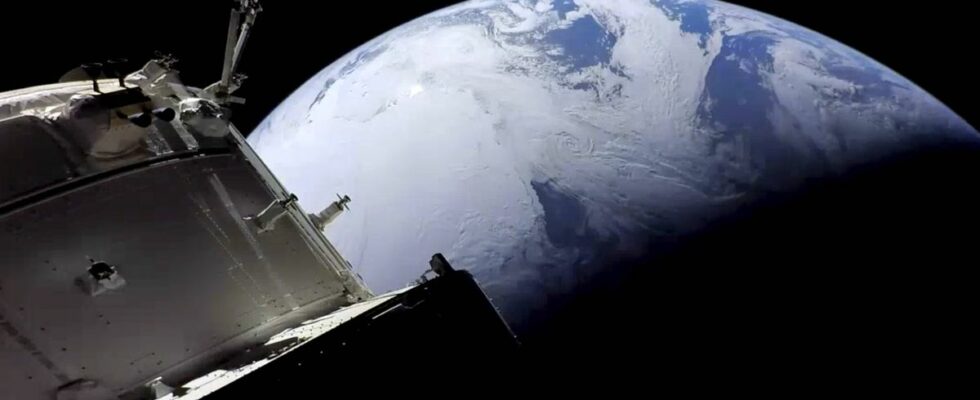Game over. After spending just over 25 days in space and orbiting the Moon, NASA’s Orion spacecraft landed in the Pacific Ocean on Sunday, marking the end of the Artemis 1 test mission, whose purpose was to prepare for the return of humans to the Moon in the coming years.
The landing took place off the Mexican island of Guadalupe. The capsule, which did not have an astronaut on board for this test flight, entered the Earth’s atmosphere at a speed of 40,000 km/h, and had to endure infernal heat of 2,800°C, i.e. half the temperature of the Sun’s surface.
Two hours in the water
The main objective of the mission was to test the capsule’s heat shield, the largest ever built (5 m in diameter), under these conditions. The spacecraft was first slowed down in its vertiginous descent by the atmosphere, then by a series of no less than eleven parachutes, until it reached a speed of around 30 km/h when it hit the water.
A US Navy ship, the USS Portland, had been pre-positioned for recovery operations, which NASA has been training for years. Helicopters and inflatable boats were also deployed. Orion must now be left in the water for two hours, much longer than if astronauts were on board, in order to collect data – in particular on the heat induced inside the capsule.
Tens of billions of dollars invested
Then divers will attach cables to it in order to tow it to the interior of the ship, the rear of which will be partly submerged. The water will then be pumped, allowing the capsule to be slowly deposited on a support provided for this purpose.
Operations are expected to take four to six hours from the time of landing. The USS Portland will then take the road to San Diego, on the American west coast, where the capsule will be landed. The success of this mission was crucial for NASA, which has invested tens of billions of dollars in the American program to return to the Moon, Artemis. After bringing humans back to the lunar surface, his goal is to prepare for a future trip to Mars.
The preparation of Artemis 2 and 3
Orion flew past the Moon just some 130 kilometers from its surface, and ventured over 430,000 km from our planet, farther than any previously habitable spacecraft. Recovering the capsule will allow the collection of a lot of decisive data for the following missions. First by detailing the state of the ship after its trip, but also by analyzing the recordings of sensors of the accelerations and vibrations undergone on board, or the performance of an anti-radiation jacket.
Certain elements of the vessel must also be reused for the Artemis 2 capsule, scheduled for 2024. It will take a crew to the Moon, still without landing there. NASA should announce the names of the chosen astronauts very soon.
Artemis 3, officially scheduled for 2025, will land for the first time on the south pole of the Moon, where there is water in the form of ice. NASA’s goal is to establish a lasting human presence on the Moon, with a base on its surface and a space station orbiting it. Learning to live on the Moon should test all the technologies needed for a multi-year journey to Mars — possibly in the late 2030s.

